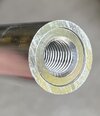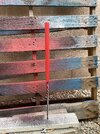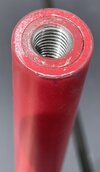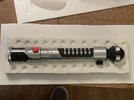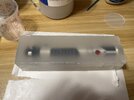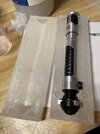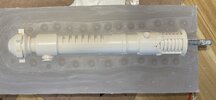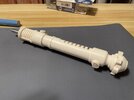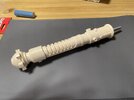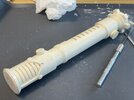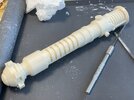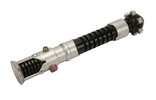Introduction
After the recently completed hero run with Anakin Starkiller, it should be apparent that I have an obsession with the Obi TPM lightsaber prop. However, that obsession is not limited to just the hero version. I have also amassed quite a collection of images of the various stunt sabers that were used. I wanted to create this post as a discussion of these stunt sabers and to outline my research and progress attempting to replicate the stunt sabers.
To help organize my thoughts I have broken down the stunt sabers into three logical groups, however there is a ton of variation between examples. As such, please understand that I am speaking in general terms and any broad statements I make apply to the average and not necessarily to every example.
Variations
1) Detailed Resin Stunt

Key Details:

Key Details:

Key Details:
My assumption is that these were generally all based on off-white / yellow urethane resin castings. The amount of detail in the painting seems to vary widely. In general on top they all seem to have a metallic silver paint and satin or glossy black paint. It is unclear whether or not any type of clear coat would have been applied. However, underneath it appears some had obvious primer layers applied, while others seem to have the appropriate paint (black or silver) applied directly to the bare resin.

The image on the left is a good representative sample of the two primary paints used, silver metallic and black with some amount of sheen. On the right is what I believe to be an example of one of the more carefully painted stunt sabers where it was clear they went through a multi stage process.
The paint scheme was not always consistent. As mentioned above the grip of the saber sometimes had a silver core, sometimes did not. The O-ring was generally left painted silver. The steps in the pommel were sometimes incorrectly painted silver. Etc. etc. etc.
Blades

Key Details:
In Post 2 I will start to detail my attempts at replicating a stunt saber and blade.
After the recently completed hero run with Anakin Starkiller, it should be apparent that I have an obsession with the Obi TPM lightsaber prop. However, that obsession is not limited to just the hero version. I have also amassed quite a collection of images of the various stunt sabers that were used. I wanted to create this post as a discussion of these stunt sabers and to outline my research and progress attempting to replicate the stunt sabers.
To help organize my thoughts I have broken down the stunt sabers into three logical groups, however there is a ton of variation between examples. As such, please understand that I am speaking in general terms and any broad statements I make apply to the average and not necessarily to every example.
Variations
1) Detailed Resin Stunt
Key Details:
- Red button and brass knob are present in detail (knurling of both can be seen to varying degrees)
- 6 pommel cubes are present though holes in cubes are generally filled (but remnants are still visible)
- All black grip vs. black & silver grip
- Threaded rod for blade vs. no threaded rod
- Wide variation in paint colors and method
- Some have covertech added, some do not
Key Details:
- Red button and brass knob are not physically present, but are painted on (remnants of brass knob hole can be seen)
- No covertech
- Pommel cubes have been removed
- Aside from variations in the paint and casting quality, these are generally fairly consistent in their major details
- Sometimes missing one LED bezel
Key Details:
- Similar to “Detailed Resin Stunt” (above) but with added metal accents such as emitter bezel, fender washer, red button, brass knob, and LED bezels
- All examples seem to have at least part of a threaded rod in the emitter
- Only two or three known variations have popped up
- Variations consist of what metal details are added
My assumption is that these were generally all based on off-white / yellow urethane resin castings. The amount of detail in the painting seems to vary widely. In general on top they all seem to have a metallic silver paint and satin or glossy black paint. It is unclear whether or not any type of clear coat would have been applied. However, underneath it appears some had obvious primer layers applied, while others seem to have the appropriate paint (black or silver) applied directly to the bare resin.
The image on the left is a good representative sample of the two primary paints used, silver metallic and black with some amount of sheen. On the right is what I believe to be an example of one of the more carefully painted stunt sabers where it was clear they went through a multi stage process.
The paint scheme was not always consistent. As mentioned above the grip of the saber sometimes had a silver core, sometimes did not. The O-ring was generally left painted silver. The steps in the pommel were sometimes incorrectly painted silver. Etc. etc. etc.
Blades
Key Details:
- All episode 1 stunt blades were either fluorescent green or red/orange, the Obi TPM saber nearly always had a green blade
- Fabricated from aluminum tubing, that was generally ~0.75”/~19mm outside diameter
- Likely had an aluminum threaded insert to attach to the threaded rod in the saber
- Most full length blades were further secured by set screws at base of blade
- Lengths varied from ~1m (for lightsaber dueling) to ~0.3m (for slicing droids, blaster deflection, etc.)
- Wall thicknesses of aluminum tube varied
- In general these were painted fluorescent green, though one notable example has what appears to be green textured tape
- Some have what appear to be a clear heat shrink film applied for protection
In Post 2 I will start to detail my attempts at replicating a stunt saber and blade.

